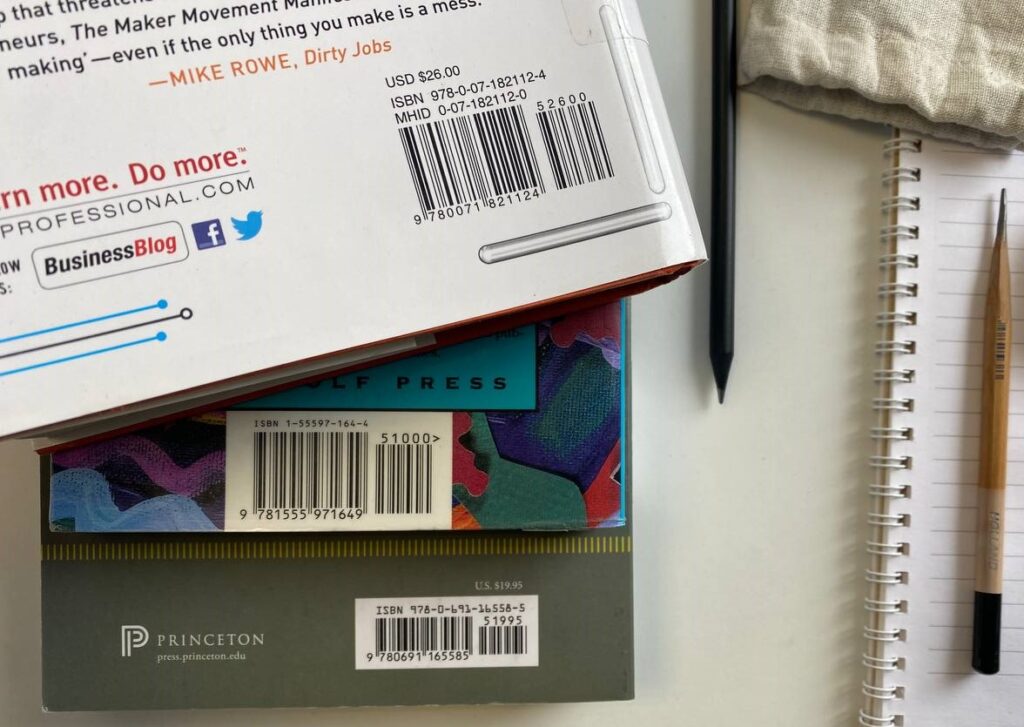
If you want to sell your old textbooks and outdated books but don’t know their ISBNs, this short guide is for you. We’ll help you find ISBNs on a book, and if there are none, we’ll give you a few tips on how to sell books without ISBNs, too.
- What Is an ISBN?
- Where Is the ISBN on a Book?
- Where to Find the ISBN of a Book?
- Books with No ISBN
- Sell Your Books with BookScouter
- How to Sell Books Without ISBN
What Is an ISBN?
ISBN stands for International Standard Book Number. It’s a distinctive code assigned to each published book to help in more efficient marketing and distribution by booksellers, libraries, universities, wholesalers, and distributors. You can usually find the ISBN on the back cover or inside the front cover, just above the barcode.
There are two types of ISBNs: a 10-digit version (ISBN-10) and a 13-digit version (ISBN-13). The 10-digit ISBN format was developed by the International Organization for Standardization (ISO) and was published in 1970 as an international standard. Later, to ensure a continuous supply of numbers and to make the system more compatible with barcode systems, the 13-digit ISBN (ISBN-13) was introduced in January 2007. The 13-digit ISBN includes the 3-digit prefix 978 or 979, identifying the number as belonging to the book publishing sector.
The ISBN helps tell one edition from another, which is super important when you want to order the right version. Another important thing is that different formats, like hardcover, paperback, eBook, etc., and different editions, like revised edition, second edition, etc., of the same book have their own unique ISBN. This helps to make sure that the book is properly identified in the worldwide book market.
Where Is the ISBN on a Book?
“Where to find isbn on book?” is a pretty common question that you’ve probably come across. You can find it on the back cover, above the barcode, or on the copyright page. It helps stores sell the book and makes sure people get the right version they want. It also helps keep track of how many books are sold and where they’re sold.

Where to Find the ISBN of a Book?
If you don’t know where to find an ISBN number, check the book’s back first, then check its copyright page, or any inner pages at the back and the front of the book.
Books with No ISBN
Before the identification system was formalized in 1970, other information was used to identify books. Books published before 1970 might have a Standard Book Numbering (SBN) code—that’s a 9-digit commercial book identifier system that came before the ISBN. But some older books don’t have either an SBN or an ISBN at all. That means there’s no unique ID for these books, which can make it a bit tougher to catalog and find them.
Here is what you can research to understand the value of a book:
- Check the book title, its author, editor, and even illustrator—this information may help find ISBN number by title—if it exists but wasn’t printed for some reason.
- Find the name of the publisher and the publishing date. If you don’t know where to find the year a book was published, check the copyright page.
- Check the book’s edition. First editions can be pretty expensive.
- Take a look at the book’s binding (paperback or hardcover).
- Check if there are any signatures or inscriptions.
Once you’ve acquired all this information, you can try offering your old books for sale on various online platforms.

Sell Your Books with BookScouter
If you’ve got books with ISBNs, BookScoutercan help you sell them. It lets you compare offers and track price changes from more than 30 vendors; you can choose the best offer and get the most cash for your books. Unfortunately, if your book doesn’t have an ISBN, BookScouter can’t help you sell it, as the vendors require each book they buy to have one.
How to Sell Books Without ISBN
Selling old books without ISBN numbers is possible through various channels. Here are some of the ways how to sell books without an ISBN:
- Value assessment: Find out the value of the book. If you suspect it might be valuable, you can contact a professional appraiser to determine its worth.
- Online platforms: List your book on peer-to-peer platforms or auction it on sites like eBay.
- Amazon exemption: If the book was printed before 1970 and does not have an ISBN, you can request an exemption to sell the book on Amazon.
- Specialized marketplaces: Antique and vintage books can be sold on specialized marketplaces such as AbeBooks.
- Dealers and auctions: You can also sell the book to a dealer or at auction, especially if it’s a rare or antique collectible. Many such dealers buy and sell rare, collectible books and first-editions (e.g., Peter Harrington Books and Bauman Rare Books, among others).
Keep in mind, however, that selling books without ISBNs can be different depending on the website or store you’re using. Some sites need an ISBN, but others let you sell books without one.
Conclusion
Now that you know a bit more about books, from such essential things as where to find ISBNs on books to more advanced stuff like ways of selling books without ISBN numbers. So, take your rare and antique books without ISBNs to an appropriate dealer, but remember that best place to sell your used textbooks and other books you won’t read again.



